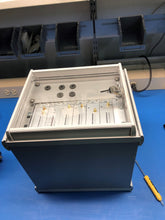The Locomotive Advanced Warning System (LAWS) is a Commercial Off the Shelf unit that is designed for a variety of locomotive control and Advanced Warning Applications. It is offered in three levels so a railway may start with a smaller budget and add-on as capital becomes available.
The Euro Rack system shown below holds the system modules which can be tailored to your application. The unit is small enough to fit under the car seat in a passenger railcar. It offers expandability to a higher level system by adding more modules.

The LAWS performs at three levels.
Level 1
The first is a standalone on-board system with no communications to WIU or other trains, so that only speed enforcement is achieved,
Speed Enforcement. The system calculates the speed zone from a lookup table and is verified by track transponder to provide the engineer with a display of the current speed zone and speed limit. A second database holds all TSR speed restrictions and workzone locations. The speed enforcement function guides the engineer regarding train speed and enforces the speed with a penalty brake after a warning is issued.
Level 2
Level 2 uses wireless communications to sparse wayside equipment such as track switches railway signals, railway crossings and other equipped trains. . No communication network and control room is needed at Level 2, but every device stated must have a MESH or FHSS radio to provide point to point communications with the trains. A small number of repeaters can be used to provide multiple RF paths around curved track.
If track signals are monitored, the engineer will have a display of the signals in his cab, making it easier and safer to see, and eventually allow de-commissioning of the wayside signals altogether.
A Collision Avoidance System is implemented if the train ahead has a LAWS system since the two may communicate directly. Without a comprehensive backbone network which provides the ultimate reliability, the system must rely on point to point communications with the train ahead and may required additional repeaters to enhance reliable data exchange in RF troublesome locations or to extend the range or to work-around track curves.
Level 3 CBTC
The third level is known as CBTC and requires a backbone Fiber Optic network and a back office control system. Full feature operation is achieved.
This CBTC can perform all the functions stated above, plus the following:
Enhanced Collision Avoidance. When the system is linked to other trains through a backbone network, higher reliability and extended range is achieved. The backbone network is designed so that every train is always within the range of a wayside unit radio.
The distance to the next train is displayed and the speed is regulated to keep the separation between trains at a distance greater than the braking distance stored in memory. With a communications back to Back-Office, new orders can be sent immediately over the network and broadcasts to all trains can be done over the shared network. Also, back office can track all trains simultaneously.
In Cab Signalling. Signals status for the next two sets are displayed on the Operator Console.
End of Train Unit monitoring The End of Train unit is a battery backed GPS receiver and a transmitter that transmits to the WIU radio receivers as the train moves. The system tracks EOT units and checks that the train length has not lengthened due to a decoupling.
Crossing advisory. The status and distance to the next crossing is transmitted to the train well in advance. The train information is also sent back to the crossing controller to act as a secondary crossing activation method.
Track Switch is wrong Position. Track switch position if wired to a WIU, can be used to indicate to the driver when turnouts are expected. The speed will also be reduced to a 15 MPH zone in advance of the switch and is enforced.
Event recorder The system records all train speed changes and compliance to the speed zone.
Incremental Implementation
A railway may elect to start small and grow as the system proves itself and as funds become available. Equipment for all phases is identical, but software will differ.
The CBTC offerings of most suppliers require a massive investment up-front and is a barrier to starting and is a disruptive installation and integration effort. With Argenia incremental approach we "Plan Big but Start Small".
There is no time to waste. Call Argenia and we can immediately start the plan and get your railway these benefits immediately. All the installation can be done by the railways own staff as trained by Argenia, so they learn how to maintain the system themselves.




